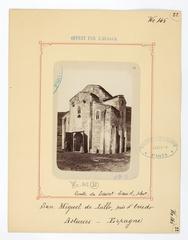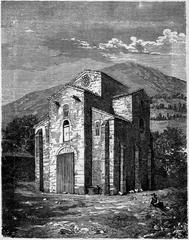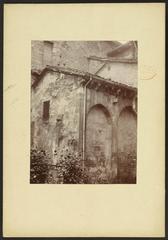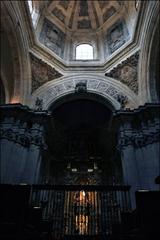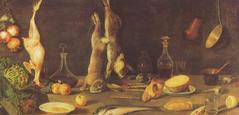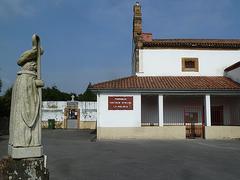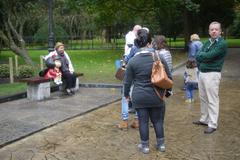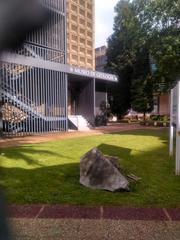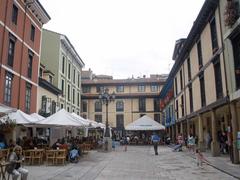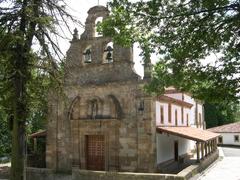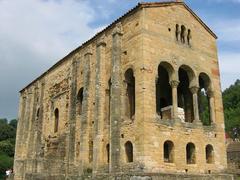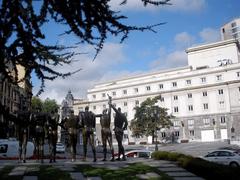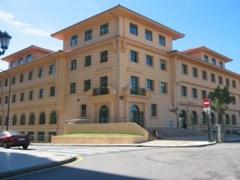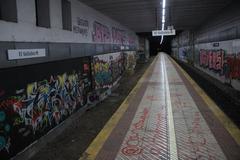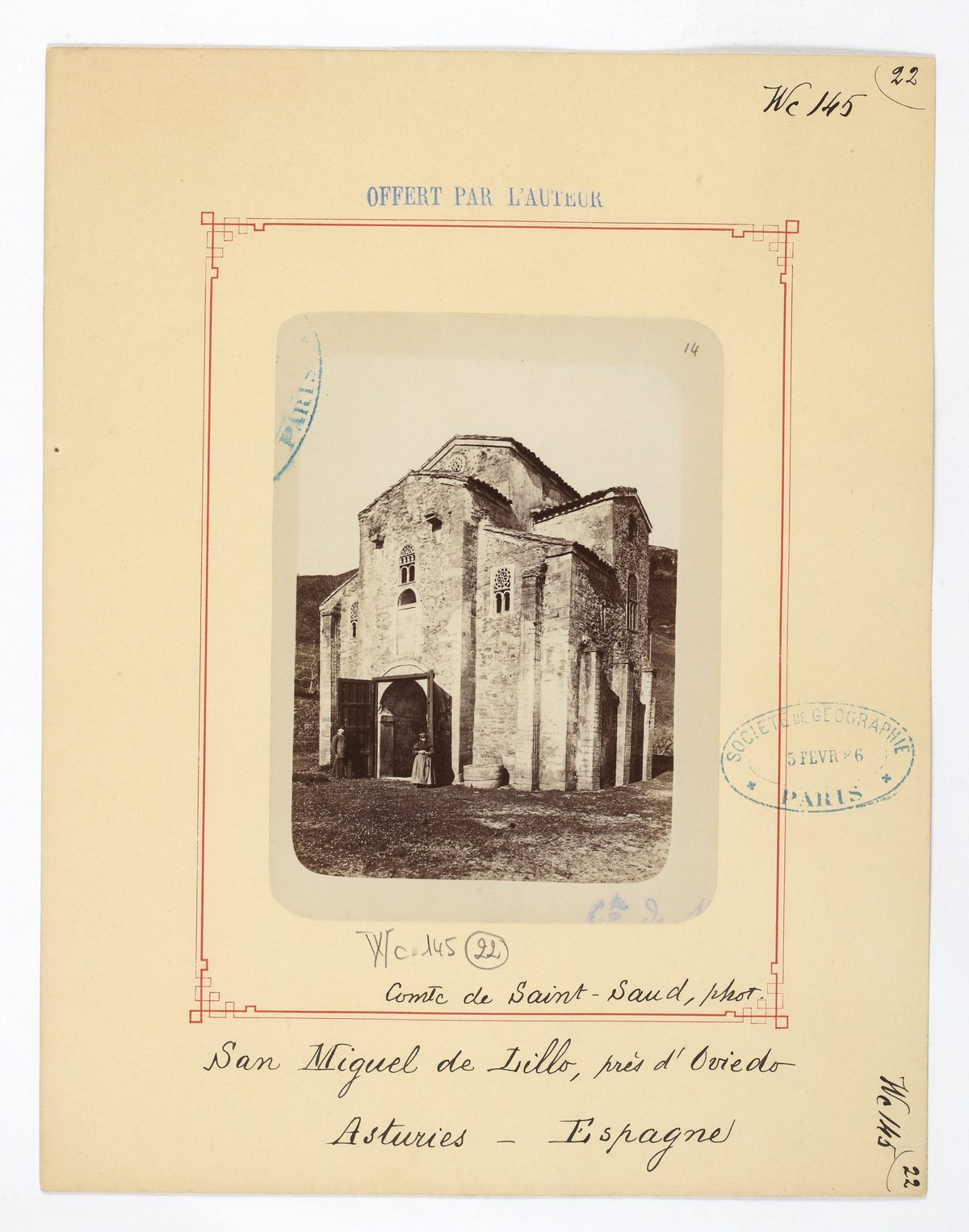
Visiting Hours, Tickets, and Historical Significance of Iglesia de San Miguel de Lillo in Oviedo City
Published Date: 23/07/2024
Introduction to Iglesia de San Miguel de Lillo
Nestled in the lush hills of Oviedo, Spain, the Iglesia de San Miguel de Lillo stands as an architectural marvel and a testament to the rich cultural heritage of the Asturian region. This pre-Romanesque church, dating back to the early 9th century, was commissioned by King Ramiro I of Asturias and originally served as part of a larger palace complex. The church’s construction began around 842 AD and was completed by 850 AD, featuring a distinctive blend of Visigothic, Mozarabic, and Carolingian architectural influences (Spain.info).
Despite the passage of centuries and numerous modifications, including significant damage from a 12th-century landslide, the Iglesia de San Miguel de Lillo has retained its historical and architectural significance. The church, with its intricate stone carvings, barrel vaults, and partially restored frescoes, offers a unique glimpse into the artistic and religious practices of medieval Spain (UNESCO).
Declared a UNESCO World Heritage Site in 1985, the church continues to attract pilgrims and tourists from around the world. It remains an active place of worship and a focal point for cultural and historical exploration in the region. This guide aims to provide a comprehensive overview of the Iglesia de San Miguel de Lillo, including its history, architectural significance, practical visitor information, travel tips, and nearby attractions (Asturias Tourism).
Table of Contents
- [Introduction to Iglesia de San Miguel de Lillo](#introduction-to-iglesia-de-san-miguel-de-lillointroduction-to-iglesia-de-san-miguel-de-lillo)
- [History of Iglesia de San Miguel de Lillo](#history-of-iglesia-de-san-miguel-de-lillohistory-of-iglesia-de-san-miguel-de-lillo)
- [Origins and Construction](#origins-and-constructionorigins-and-construction)
- [Architectural Significance](#architectural-significancearchitectural-significance)
- [Historical Events and Modifications](#historical-events-and-modificationshistorical-events-and-modifications)
- [Cultural and Religious Importance](#cultural-and-religious-importancecultural-and-religious-importance)
- [Visitor Information](#visitor-informationvisitor-information)
- [Ticket Prices and Visiting Hours](#ticket-prices-and-visiting-hoursticket-prices-and-visiting-hours)
- [Accessibility](#accessibilityaccessibility)
- [Travel Tips](#travel-tipstravel-tips)
- [Transportation](#transportationtransportation)
- [Recommended Times to Visit](#recommended-times-to-visitrecommended-times-to-visit)
- [Nearby Attractions](#nearby-attractionsnearby-attractions)
- [Preservation Efforts](#preservation-effortspreservation-efforts)
- [Influence on Later Architecture](#influence-on-later-architectureinfluence-on-later-architecture)
- [Archaeological Discoveries](#archaeological-discoveriesarchaeological-discoveries)
- [Visitor Experience](#visitor-experiencevisitor-experience)
- [Conclusion](#conclusionconclusion)
- [FAQ](#faqfaq)
- [Call to Action](#call-to-actioncall-to-action)
History of Iglesia de San Miguel de Lillo
Origins and Construction
The Iglesia de San Miguel de Lillo, commissioned by King Ramiro I of Asturias, dates back to the early 9th century. Originally part of a larger palace complex, its construction began around 842 AD and was completed by 850 AD. The architectural style is a testament to the Asturian pre-Romanesque period, characterized by a unique blend of Visigothic, Mozarabic, and Carolingian influences (Spain.info).
Architectural Significance
Originally designed as a basilica with three naves, only the western part of the Iglesia de San Miguel de Lillo remains today due to structural issues. The surviving structure includes the vestibule, choir, and the first section of the naves. Noteworthy features include intricate stone carvings and the use of barrel vaults, which were innovative for the time (UNESCO).
Historical Events and Modifications
The church has undergone several modifications and restorations. In the 12th century, a landslide caused significant damage, leading to the collapse of the eastern part of the building. Subsequent restorations aimed to preserve its architectural integrity. Notably, the church’s frescoes, depicting various religious scenes, were restored in the 20th century (Asturias Tourism).
Cultural and Religious Importance
Declared a UNESCO World Heritage Site in 1985, the Iglesia de San Miguel de Lillo is a prime example of Asturian pre-Romanesque architecture. It continues to be a place of worship and a site for religious ceremonies, attracting pilgrims and tourists alike (UNESCO).
Visitor Information
Ticket Prices and Visiting Hours
Visitors can explore the Iglesia de San Miguel de Lillo with guided tours available. Typical visiting hours are from 10:00 AM to 6:00 PM, but it is advisable to check the latest schedule on official websites. Ticket prices generally range from €3 to €5, with discounts available for students and seniors.
Accessibility
The church is accessible to visitors with mobility issues, although some areas may be challenging due to the terrain. It is recommended to contact the site ahead of time for specific accessibility arrangements.
Travel Tips
Transportation
The Iglesia de San Miguel de Lillo is easily reachable by car or public transportation from Oviedo. Buses and taxis are available, with ample parking close to the site.
Recommended Times to Visit
To avoid crowds and enjoy a more serene experience, consider visiting during weekdays or early morning hours. Spring and autumn offer pleasant weather and fewer tourists.
Nearby Attractions
While in Oviedo, visitors can explore other historical sites such as the Santa María del Naranco and the San Julián de los Prados. The city’s old town also offers charming streets, local cuisine, and cultural experiences.
Preservation Efforts
Ongoing preservation efforts by the Spanish government and various cultural organizations ensure the longevity of the Iglesia de San Miguel de Lillo. These efforts include structural reinforcements, climate control measures to protect frescoes, and regular maintenance of stone carvings (Spain.info).
Influence on Later Architecture
The architectural style of the Iglesia de San Miguel de Lillo has influenced later Romanesque and Gothic structures in Spain. Its unique blend of elements from different cultures reflects the diverse influences that have shaped Spanish architecture over the centuries (Asturias Tourism).
Archaeological Discoveries
Excavations around the church have uncovered artifacts that provide insights into its history and the daily lives of its builders. These discoveries include religious relics, tools, and remnants of the original palace complex (UNESCO).
Visitor Experience
Visitors can enjoy guided tours that offer detailed explanations of the church’s construction, historical significance, and preservation efforts. The serene setting provides a tranquil environment for reflection and appreciation of this historical monument.
Conclusion
The Iglesia de San Miguel de Lillo stands as a remarkable example of Asturian pre-Romanesque architecture and a testament to the region’s rich cultural heritage. Its enduring significance continues to attract visitors from around the world. Through ongoing preservation efforts, the church remains a well-preserved symbol of Spain’s architectural legacy.
FAQ
Q: What are the visiting hours for the Iglesia de San Miguel de Lillo?
- A: Typical visiting hours are from 10:00 AM to 6:00 PM. Check official websites for the latest schedule.
Q: How much are the tickets for visiting the church?
- A: Ticket prices generally range from €3 to €5, with discounts for students and seniors.
Q: Is the Iglesia de San Miguel de Lillo accessible for visitors with mobility issues?
- A: Yes, but some areas may be challenging. Contact the site ahead for specific accessibility arrangements.
Q: What are some nearby attractions to visit?
- A: Nearby attractions include the Santa María del Naranco, San Julián de los Prados, and Oviedo’s old town.
Call to Action
Download the Audiala app for more updates on historical sites, check out our other related posts, and follow us on social media for the latest travel tips and information.
